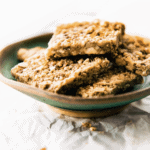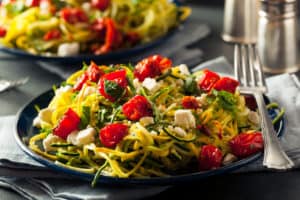What Is a Plant-Based Diet?
A plant-based diet is exactly what it sounds like: a diet where all the aspects of it come from plants in some way. This doesn’t just mean eating nothing but salad. There are some enduring misconceptions about plant-based diets being dull and lettuce based, but in truth, there is an extraordinary number of grains, legumes, pulses, oils, plus meat and dairy substitutes.
 Many people switch to a plant-based diet for health reasons. There is plenty of evidence that eating too much red meat, especially processed meats like bacon and sausage, has negative health impacts. Some people have found that cutting down on their meat and dairy intake can help them lose weight.
Many people switch to a plant-based diet for health reasons. There is plenty of evidence that eating too much red meat, especially processed meats like bacon and sausage, has negative health impacts. Some people have found that cutting down on their meat and dairy intake can help them lose weight.
Other people switch to a plant-based diet for ethical reasons. This may be because they believe in the equality of animals and people and believe in minimizing harm to other creatures. It may also be because of the potential impact that the meat industry could be having on climate change.
While a true plant-based diet would be, by its very nature, vegan, people can also take the plant-based approach without cutting out every aspect of meat or dairy. Some people still enjoy the occasional egg or a touch of honey in a salad dressing. This choice depends on whether you’re going plant-based for health or ethical reasons.
What’s a Whole-Food, Plant-Based Diet?
A whole-food, plant-based diet (WFPB) is a lifestyle choice, which combines the basics of a plant-based diet with the following conditions:
- No (or very little) refined sugars
- No (or very little) white flour
- Minimal amounts of processed oils
- A focus on locally sourced and organic produce
- Avoiding pre-made meals and cooking from scratch
- Focusing on fresh fruit, veggies, legumes and pulses
WFPB is a little stricter than the standard plant-based diet and doesn’t leave room for plant-protein patties- unless you make them yourself. However, it’s a wonderful way to explore the many ways you can live well off very simple foods and ingredients.
Common Misconceptions About Plant-Based Diet Plans

Where does your protein come from? A widespread misconception about plant-based eating is that it’s a low protein affair. Not all protein comes from meat and dairy. Here are just a few amazing sources of protein, which are totally fine on a plant-based diet:
- Quinoa contains all 9 essential amino acids. Check that it’s sustainably sourced.
- Seitan, a “mock meat” made from wheat gluten. Not suitable for those with celiac disease or other gluten intolerances.
- Soy, including edamame beans, tofu, and tempeh. Another great source of all the essential amino acids.
- Lentils, which also provide slow-release carbs and fiber.
- Other great sources of protein include beans, chickpeas, hempseed, peas, nuts and nut butter, oats, and chia seeds
There are many others to add to this list, including some weird additions like certain types of blue-green algae! Hopefully, this list illustrates that it’s easy and delicious to get your protein from a plant-based diet.
“There’s Not Enough Choices…”
Even the shortlist of protein options above blows that supposition right out of the water. However, going beyond searching for great protein fixes, there’s every vegetable in the world, every fruit in the world, so many oils, nuts, seeds, grains, and anything that can be made from any of those products.
Add to that the fact that with the growing rise in veganism, there are more and more plant-based products on the grocery store shelves every day. A lack of choice is not something to worry about when it comes to plant-based eating.
“Aren’t You Always Hungry?”
This is a bizarre yet enduring misconception that must be leftover from the days when “plant-based” meant eating a leaf of lettuce while meditating in a field. Newsflash: plant-based has never meant that, but that’s the image many people had for a long time before the idea became widespread.
As long as you’re eating plenty of protein, carbs, fiber, some fat, and the right amounts of micronutrients, you won’t feel hungry. It’s important to drink plenty too, so make sure you include lots of water in your daily plan.

“Plant-Based Eating Is So Expensive!”
Not really. Several meat substitutes can be expensive, and specialist products are out there, enticing plant-based fans into parting with their hard-earned cash. But a little bit of knowledge about what fruit and veg are seasonal and how to cook them in a few different ways can save you a ton of money.
If your favorite veg is seasonal in summer, buy extra and freeze some. This is especially useful for soft fruits like blueberries, which freeze well and can be turned into smoothies or amazing desserts.
What Foods Can You Eat on a Plant-Based Diet Plan?
A plant-based diet plan isn’t anywhere as restrictive as you might think. There are so many amazing foods you can include, and these can become even more exciting, depending on your sense of adventure in the kitchen. When creating your own plant-based diet meal plan, a combination of substitutes for your favorite meat or dairy dishes and new, plant-based recipes will keep your meals exciting and appealing.
For example, there are plenty of amazing burger substitutes, so one night could be burger night, and another night could be stir fry night, using fresh, crunchy veg and tofu.
Fruits
It’s impossible to list all the fruits that you can enjoy as part of your new plant-based journey. There are so many, from giant pomelos to a wealth of berries. Here are just a few of the more popular ones to start you on your way:
- Coconut- A whole one is fun to crack open plus provides “milk” as well as fruit. It can be bought dried as a cupboard staple, which lasts for months. Coconut flour is also available, which is excellent for baking.
- Bananas are an excellent source of energy.
- Apples are full of health benefits plus refreshing.
- Oranges and other citrus fruit are packed with vitamin C.
- Pineapple is full of essential micronutrients.
- Avocado is a great source of healthy fats and fiber.
- Blueberries are a tasty fix of antioxidants.
- Pomegranates are fun to eat and packed with nutrients.
- Strawberries are a low Glycemic Index rating plus high in vitamin C and manganese.
Plus, there are lots of exciting ways to play with fruit and make it more exciting. How about making your own grape jelly or apple sauce?
Vegetables
Vegetables cover such a broad range of produce, from herbs to zucchini and everything in between. This list includes things that might technically be classed as a fruit, but will normally be found with vegetables in the grocery store.
- Tomatoes- let’s get the “fruit in disguise” out of the way first. Tomatoes are absolutely fruit as they contain seeds; however, they’re normally classed as a vegetable in cooking and shopping because of their main application as an ingredient of savory dishes. They’re packed with vitamin C and important antioxidants.
- Carrots are an important source of vitamin A and beta-carotene, and an antioxidant linked to a reduced risk of cancer in several studies.
- Potatoes are an underrated vegetable, primarily because many people associate it with fries and nothing else. Potatoes are a great source of carbs, plus they contain potassium, calcium, iron, phosphorus, and a surprising amount of vitamin C.
- Spinach has all your daily vitamin K sorted in one serving.
- Corn is a great source of insoluble fiber to aid in digestion plus lutein, which is good for your eyes.
- Garlic is naturally anti-viral, immune system boosting, and may even reduce blood pressure and promote a healthier heart.
- Onions are used in so many cuisines plus filled with vitamin C and beneficial phytochemicals.
- Red cabbage can provide 85% of the recommended daily value of vitamin C with just one cup. Plus, it’s a tasty source of fiber. Sauté lightly in olive oil with a bit of garlic, steam, or chop and mix with shredded carrot and onion for a quick and easy slaw.
- Asparagus is an excellent source of folate.
Legumes
Legumes mean the seeds or fruits of plants from the Fabaceae family. They’re often classed as being vital to the plant-based diet, as they are so high in protein. Examples include:
- Peas are an amazing source of dietary fiber and protein. They’re also an excellent source of vitamin K.
- Soybeans are really high in protein and available in a variety of easily prepared forms.
- Lima Beans, also known as butter beans, contain potassium, phosphorous, and a range of antioxidants.
- Alfalfa, which is basically a sprouted seed, making them highly nutritious and packed with protein.
There is an incredible range of beans, peas, pulses, and lentils, so experiment and find your favorites.
Nuts
All nuts are high in protein, but the reason nuts are so essential for a plant-based diet is the range of beneficial oils and fats. Remember, you need healthy fat. Nuts are a great source of this and can help keep your micronutrients topped up too. Plus, they’re a great snack on the go.

Dairy Alternatives
Dairy alternatives can be tricky if you’re diet has been quite milk-heavy previously. Here are the main options currently:
- Almond milk
- Soy milk
- Oat milk
- Coconut milk
- Cashew milk
- Rice milk
- Hemp milk
Check the label and see which have been fortified with vitamin D or other nutrients. To mimic dairy, the substitute should contain around 120mg calcium per 100ml of product. Avoid those with added sugar, unless you really can’t stand the taste of the unsweetened version.
What Are the Benefits of Plant-Based Diets?
As well as going plant-based to protect the planet or for other ethical reasons, plenty of people want to explore the health benefits of this lifestyle.
Heart Disease
A plant-based diet that focuses on fresh fruit and vegetables could lead to a lower risk of heart disease. This includes cutting out sugary drinks and refined grains, and even fruit juice should be kept to a minimum. This is where the whole-food, plant-based diet comes into its own.
Weight Management
Cutting out on processed food and meats automatically rid you of plenty of hidden sugars, fats, and salts, you probably never realized you were consuming. Plant-based eating is focused around a healthy, balanced lifestyle plan rather than a fad diet, so the chances are, those pounds you lose will stay off.
Diabetes
It’s possible that a plant-based diet could help improve blood sugar control. This is beneficial to those both already dealing with diabetes and concerned about developing it.
Other Potential Benefits
Other benefits of a plant-based diet include:
- Fresher breath
- Virtually no saturated fat, great for cardiovascular health
- Better digestion
- Potentially lower cholesterol
- May improve eye health
- Greater energy levels
Are There Are Downsides to Plant-Based Meal Plans?
The main thing to consider when making a plant-based meal plan is making sure you get a good balance of all the essential nutrients.
If switching from a high meat content diet, think about how you will replace that protein. If you’re going to replace five meals a week with beans, you’re going to get bored pretty quick. Mix it up and get inventive. Quinoa, tofu, and peas are all a great protein source, so maybe have bean chili one day, a stir-fry with sugar snap peas another, fried tofu another day, and a zest quinoa salad on yet another day, still leaving plenty of options open for curries, soups, stews and more.
Browse your local grocery store for plant-based options, and keep your eye on what’s in season. It may surprise you just how many options are open to you.







